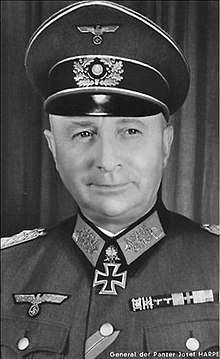Josef Harpe
Josef Harpe (21 September 1887 – 14 March 1968) was a German general during World War II who commanded the 9th Army. He was a recipient of the Knight's Cross of the Iron Cross with Oak Leaves and Swords of Nazi Germany.
Josef Harpe | |
|---|---|
 | |
| Born | 21 September 1887 Buer, German Empire |
| Died | 14 March 1968 (aged 80) Nuremberg, West Germany |
| Allegiance | |
| Service/ | Army (Wehrmacht) |
| Years of service | 1909–45 |
| Rank | |
| Commands held | 12th Panzer Division XXXXI Panzer Corps 9th Army Army Group North Ukraine Army Group A 4th Panzer Army 5th Panzer Army |
| Battles/wars | World War I
Vistula–Oder Offensive |
| Awards | Knight's Cross of the Iron Cross with Oak Leaves and Swords |
Harpe served on the Eastern Front, where he commanded XXXXI Panzer Corps and the 9th Army. From September 1944 to January 1945 Army Group A, when he was relieved of his command due to the inability of German forces to stop the Soviet Vistula–Oder Offensive. He ended the war commanding the 5th Panzer Army on Western Front.
Military career
Harpe joined the Prussian Army on 28 September 1909 and fought in World War I. After the war, Harpe remained in the Reichswehr military service. In 1931, under the pseudonym Direktor Hacker, he held a position in the secret German-Russian Tank-School (Kama tank school) in Kazan, Soviet Union. He was promoted to Oberstleutnant on 1 August 1934 and became commander of Panzer-Regiment 3 on 15 October 1935. He was again promoted on 1 January 1937, and commanded the German 1st Panzer Brigade holding the rank of Oberst. In 1940 he took over as Commandant of the Armoured Troops School No.2 in Wünsdorf.
He served on the Eastern Front, where he commanded, from July 1942 until October 1943 the XXXXI. Panzerkorps and from September 1944 to January 1945 Army Group A. He was relieved of his command due to the inability of German forces to stop the Soviet Vistula–Oder Offensive, which resulted in the Soviet capture of most of Poland. He ended the war as the commander of the 5th Panzer Army on the Western Front. He was held as a prisoner of war by the United States until 1948.
Awards
- Iron Cross (1914) 2nd Class (21 September 1914) & 1st Class (3 September 1915)[1]
- Wound Badge (1914) in Black (20 May 1918)[2]
- Wehrmacht Long Service Award 1st Class (2 October 1936)[2]
- Clasp to the Iron Cross (1939) 2nd and 1st Class[2]
- Knight's Cross on 13 August 1941 as Generalmajor and commander of the 12. Panzer-Division[3]
- Oak Leaves on 31 December 1941 as Generalmajor and commander of the 12. Panzer-Division[3]
- Swords on 15 September 1943 as General der Panzertruppe and commanding general of the XXXXI. Panzerkorps[3]
- German Cross in Gold on 19 February 1943 as General der Panzertruppe and commanding general of the XXXXI.Panzerkorps[4]
References
Citations
- Thomas 1997, p. 248.
- Wegmann 2009, p. 238.
- Scherzer 2007, p. 367.
- Patzwall & Scherzer 2001, p. 165.
Bibliography
- Patzwall, Klaus D.; Scherzer, Veit (2001). Das Deutsche Kreuz 1941 – 1945 Geschichte und Inhaber Band II [The German Cross 1941 – 1945 History and Recipients Volume 2] (in German). Norderstedt, Germany: Verlag Klaus D. Patzwall. ISBN 978-3-931533-45-8.CS1 maint: ref=harv (link)
- Scherzer, Veit (2007). Die Ritterkreuzträger 1939–1945 Die Inhaber des Ritterkreuzes des Eisernen Kreuzes 1939 von Heer, Luftwaffe, Kriegsmarine, Waffen-SS, Volkssturm sowie mit Deutschland verbündeter Streitkräfte nach den Unterlagen des Bundesarchives [The Knight's Cross Bearers 1939–1945 The Holders of the Knight's Cross of the Iron Cross 1939 by Army, Air Force, Navy, Waffen-SS, Volkssturm and Allied Forces with Germany According to the Documents of the Federal Archives] (in German). Jena, Germany: Scherzers Militaer-Verlag. ISBN 978-3-938845-17-2.CS1 maint: ref=harv (link)
- Thomas, Franz (1997). Die Eichenlaubträger 1939–1945 Band 1: A–K [The Oak Leaves Bearers 1939–1945 Volume 1: A–K] (in German). Osnabrück, Germany: Biblio-Verlag. ISBN 978-3-7648-2299-6.CS1 maint: ref=harv (link)
- Wegmann, Günter (2009). Die Ritterkreuzträger der Deutschen Wehrmacht 1939–1945 Teil VIIIa: Panzertruppe Band 2: F–H [The Knight's Cross Bearers of the German Wehrmacht 1939–1945 Part VIIIa: Panzer Force Volume 2: F–H] (in German). Bissendorf, Germany: Biblio-Verlag. ISBN 978-3-7648-2389-4.CS1 maint: ref=harv (link)
| Military offices | ||
|---|---|---|
| Preceded by Paul Bader |
Commander of 2. Infanterie-Division 5 October 1940 – 10 January 1941 |
Succeeded by 12. Panzerdivision |
| Preceded by 2. Infanterie-Division |
Commander of 12. Panzerdivision 10 January 1941 – 15 January 1942 |
Succeeded by Generalleutnant Walter Wessel |
| Preceded by General of Panzer Troops Walther Model |
Commander of XXXXI Army Corps renamed July 1942 XXXXI Panzerkorps 15 January 1942 – 15 October 1943 |
Succeeded by General of Artillery Helmuth Weidling |
| Preceded by Generalfeldmarschall Walter Model |
Commander of 9. Armee 4 November 1943 – 19 May 1944 |
Succeeded by General Hans Jordan |
| Preceded by Generaloberst Erhard Raus |
Commander of 4. Panzer-Armee 18 May 1944 – 28 June 1944 |
Succeeded by General der Panzertruppe Walther Nehring |
| Preceded by Generalfeldmarschall Walter Model |
Commander of Army Group North Ukraine renamed September 1944 Army Group A 16 August 1944 – 17 January 1945 |
Succeeded by Generaloberst Ferdinand Schörner |
| Preceded by General der Panzertruppe Hasso von Manteuffel |
Commander of 5. Panzer-Armee 8 March 1945 – 17 April 1945 |
Succeeded by none |